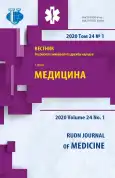The use of various types of autografts in the bone grafting of the alveolar process
- 作者: Makeev A.V.1, Topolnitsky O.Z.1, Fedotov R.N.1
-
隶属关系:
- A.I. Yevdokimov Moscow State University of Medicine and Denistry
- 期: 卷 24, 编号 1 (2020)
- 页面: 69-74
- 栏目: Stomatology
- URL: https://journal-vniispk.ru/2313-0245/article/view/319583
- DOI: https://doi.org/10.22363/2313-0245-2020-24-1-69-74
- ID: 319583
如何引用文章
全文:
详细
Relevance. Fixing a cleft alveolar process is one of the most complicated problems in pediatric maxillofacial surgery. The difficulty lies in the fact that bone grafting of the alveolar process directly affects the growth of the upper jaw, the difficulty of performing surgery, as well as trying to form a sufficient amount of bone regenerate, while it is necessary to restore the anatomical integrity of the alveolar process for subsequent orthodontic treatment or dental implantation. Purpose: To review the literature on the use of autografts from various donor areas in patients with congenital cleft upper lip, alveolar process, hard and soft palate. Materials and methods: A literature review of the data was carried out using the electronic databases “Medline”, “Pubmed”, “Kibeleninka”. The key words in the search were: bone plastic, cleft alveolar process. The selection criteria were the articles in English and Russian containing clinical studies on the use of various types of grafts in bone grafting of the alveolar process cleft. Results: The sources of literature on the use of various autografts for bone grafting of the alveolar outgrowth in children with cleft lip and palate were analyzed. Currently, most authors are inclined to use an iliac crest autograft in surgery. Conclusion: Although more than a century has passed since the first alveolar cleft bone graft surgery was performed, the choice of bone material is still unresolved - due to the severity of complications, the impossibility of taking a sufficient amount of bone material, as well as a high percentage of material resorption, because even with the use of iliac crest bone, the volume of transplant resorption can be over 40%.
作者简介
A. Makeev
A.I. Yevdokimov Moscow State University of Medicine and Denistry
编辑信件的主要联系方式.
Email: docartemmakeev@gmail.com
Moscow, Russian Federation
O. Topolnitsky
A.I. Yevdokimov Moscow State University of Medicine and Denistry
Email: docartemmakeev@gmail.com
Moscow, Russian Federation
R. Fedotov
A.I. Yevdokimov Moscow State University of Medicine and Denistry
Email: docartemmakeev@gmail.com
Moscow, Russian Federation
参考
- Ershova O. Yu., Leonov A.G., Tkachenko A.E., Dolgopolova G.V. Complex approach to rehabilitation of children with congenital cleft upper lip and sky in a specialized center. Electronic scientific journal. System of integration in health care. 2015; (25): 26—35. (In Russ.)
- Ershova O. Yu., Leonov A.G., Tkachenko A.E., Dolgopolova G.V. Experience of using a biodegradable membrane in alveolar surgery in children with congenital cleft upper lip, sky and alveolar process. Bulletin of the Ural Medical Academic Science. 2016; (3): 27—32. (In Russ.)
- Boyne P.J., Sands N.R. Secondary bone grafting of residual alveolar and palatal clefts. J. Oral Surg. 1972;30:87—92.
- Bajaj A.K., Wongworawat A.A., Punjabi A. Management of alveolar clefts. J. Craniofac. Surg. 2003;14:840—6.
- Ma’amon A.R., Telfah H. Secondary alveolar bone grafting: the dilemma of donor site selection and morbidity. Br.J. Oral Maxillofac. Surg. 2008;46:665—70.
- Malcolm C., Johnston P. Embryogenesis of cleft lip and palate. Plast. Surg. 1990;4:2532.
- Enemark H., Sindet-Pedersen S., Bundgaard M. Long-term results after secondary bone grafting of alveolar clefts. J. Oral Maxillofac. Surg. 1987;45:913—9.
- Guo J., Li C., Zhang Q., Wu G., Deacon S.A., Chen J., Hu H, Zou S, Ye Q. Secondary bone grafting for alveolar cleft in children with cleft lip or cleft lip and palate. Cochrane Database Syst. Rev. 2011;6. CD008050.
- Cohen M. Harvesting iliac bone graft: decreasing the morbidity. Cleft Palate Craniofac. J. 2000;37:599.
- Long R.E., Paterno M., Vinson B: Effect of cuspid positioning in the cleft at the time of secondary alveolar bone grafting on eventual graft success. Cleft Palate Craniofac J 33:225, 1996.
- Khojasteh A., Kheiri L., Motamedian S.R., Nadjmi N. Regenerative medicine in the treatment of alveolar cleft defect: a systematic review of the literature. J. Craniomaxillofac. Surg.2015;43:1608—13.
- Boyne P.J., Sands N.R. Secondary bone grafting of residual alveolar and palatal clefts. J. Oral Surg. 1972;30:87—92.
- Cohen M. Harvesting iliac bone graft: decreasing the morbidity. Cleft Palate Craniofac. J. 2000;37:599.
- Wójcicka K., Kobus K., Wójcicki P. Epidemiology of Lip, Alveolar Process and Palate Clefts in the Material of Hospital and Clinic of Plastic Surgery in Polanica Zdrój. Pol. J. Surg. 2009;81(1):4—11.
- Gundlach K.K., Maus C. Epidemiological studies on the frequency of clefts in Europe and world-wide. J. Craniomaxillofac. Surg. 2006. Sep;34 Suppl 2:1—2.
- Millard R. Boston: Little, Brown; 1980. Cleft Craft. Vol. 3; pp. 299—301.
- Sindet-Pedersen S, Enemark H. Mandibular bone grafts for reconstruction of alveolar clefts. J. Oral Maxillofac. Surg. 1988;46:533—7.
- Ageeva L.V., Savitskaya G.M., Yulova N.A., Volo-jin A.I., Mamedov AA, Petukhova LI. Application of membranes with osteoinductive properties to eliminate defects in the alveolar process of the upper jaw and hard sky. In: Roginsky VV, ed. by Moscow Center for Children’s Oral and Maxillofacial Surgery. 10 years of work. Results. Results. Conclusions. Moscow: Detstomizdat; 2002. p. 31—6. (In Russ.)
- Fahradyan A., Tsuha M., Wolfswinkel E.M., K.A.S. Mitchell, J.A. Hammoudeh, W. Magee. Optimal timing of secondary alveolar bone grafting: a literature review. J Oral Maxillofac Surg. 2018; Nov. 77(7):843—849.
- Honma K., Kobayashi T., Nakajima T., et al: Computed tomographic evaluation of bone formation after secondary bone grafting of alveolar clefts. J Oral Maxillofac Surg 57:1209, 1999
补充文件









